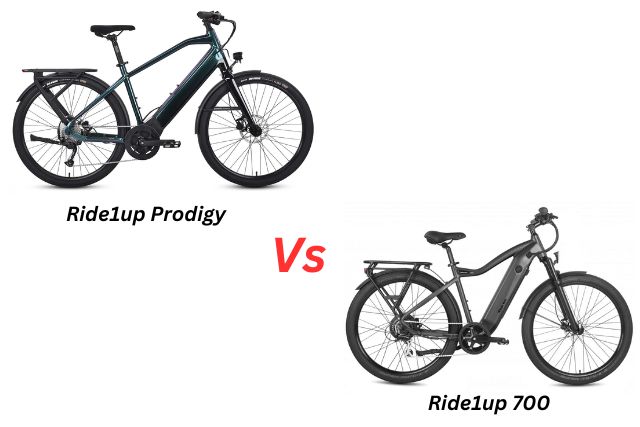
If you are looking for a new e-bike that can handle various terrains and offer a comfortable and powerful ride, you might be interested in comparing two models from Ride1UP: the Prodigy and the 700 Series.
These are both high-quality e-bikes that have many features in common, but also some differences that might suit your preferences and needs better.
We will compare Prodigy and the 700 Series, based on their components, specs, performance, and use cases.
Components and Specs
The Prodigy and the 700 Series share some components, such as the 750W geared hub motor, the 15Ah Samsung cell battery, the Zoom dual piston hydraulic disc brakes, the Shimano Acera 8-speed derailleur and shifters, and the KD21C LCD display.
However, they also have some notable differences in other components, such as:
Fork
The Prodigy has a Mozo hydraulic suspension fork with 80mm of travel and lockout, while the 700 Series has a Suntour XCT suspension fork with 100mm of travel and preload adjustment.
Tires
The Prodigy has Chaoyang SandStorm 26″x3″ fat tires, while the 700 Series has Schwalbe Super Moto-X 27.5″x2.4″ tires.
Handlebars
The Prodigy has two options for the frame: step-through (ST) or extended range (XR).
The ST has a Zoom handlebar with 50mm rise and 40° sweep, while the XR has a Promax handlebar with 30mm rise and 9° sweep. The 700 Series has only one frame option with a Promax handlebar with 30mm rise and 9° sweep.
Fenders
The Prodigy comes with metal alloy fenders included, while the 700 Series comes with plastic fenders included.
Rear rack
The Prodigy has a 130lb rated rack that is compatible with a passenger kit (sold separately), while the 700 Series has a standard rack that is not compatible with a passenger kit.
Lights
The Prodigy has a Buchel Shiny 80 Lux front light and a Velo Edge tail light, while the 700 Series has an integrated front light and a Spanninga Solo tail light.
Related: Ride1up Cafe Cruiser vs. 700: Detailed Comparison
Performance and Use Case
Both the Prodigy and the 700 Series are capable of reaching up to 28mph with pedal assist and up to 20mph with throttle. They also have similar ranges of 30-50 miles depending on the riding conditions and settings. However, they differ in their weight, ride quality, and use case.
Weight
The Prodigy is heavier than the 700 Series, weighing 65 lbs versus 62 lbs. This might affect the portability and maneuverability of the e-bike, especially if you need to carry it upstairs or load it on a car rack.
Ride quality
The Prodigy offers a smoother and more stable ride than the 700 Series, thanks to its fat tires that can absorb shocks and bumps well. It has a more comfortable saddle and grips than the 700 Series.
However, the fat tires also add more rolling resistance and drag than the narrower tires of the 700 Series, which might affect the speed and efficiency of the e-bike.
Use case
The Prodigy is more suitable for leisure commuting on variable terrains, such as sand, snow, gravel, or dirt. It can accommodate a passenger with the optional kit.
The 700 Series is more suitable for urban commuting on paved roads or bike lanes. It can also handle some light trails or hills with its suspension fork.
Read Also: Radcity 3 vs. 4: Compared
Conclusion
The Prodigy and the 700 Series are both excellent e-bikes from Ride1UP that offer a lot of value for their price. Though, they have different strengths and weaknesses that might appeal to different riders.
If you want an e-bike that can handle any terrain and provide a smooth and comfortable ride, you might prefer the Prodigy.
If you want an e-bike that can zip through traffic and offer a more agile and efficient ride, you might prefer the 700 Series.
Ultimately, the choice depends on your personal preferences and needs.

